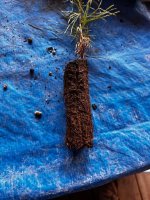I bought a group of Western White pine seedlings that were obviously grown in a tube. I don't care for tubed seedlings because I don't like the roots that are all jammed up in a group like they are. This plug is about 4.5" long. I bought these in late fall and originally planted them in the pot as shown in a group. One of the problems that I see is that the wad of roots soaks up water and they seem to be damp all the time. These are just now starting to bud out. Should I be trying to tease out, or comb out these roots a bit and then replanting in maybe pumice and a little bark chips? I have a hard time believing that I should plant them like they are. Should I cut off some of the roots and then tease out the rest or ? Help appreciated.


